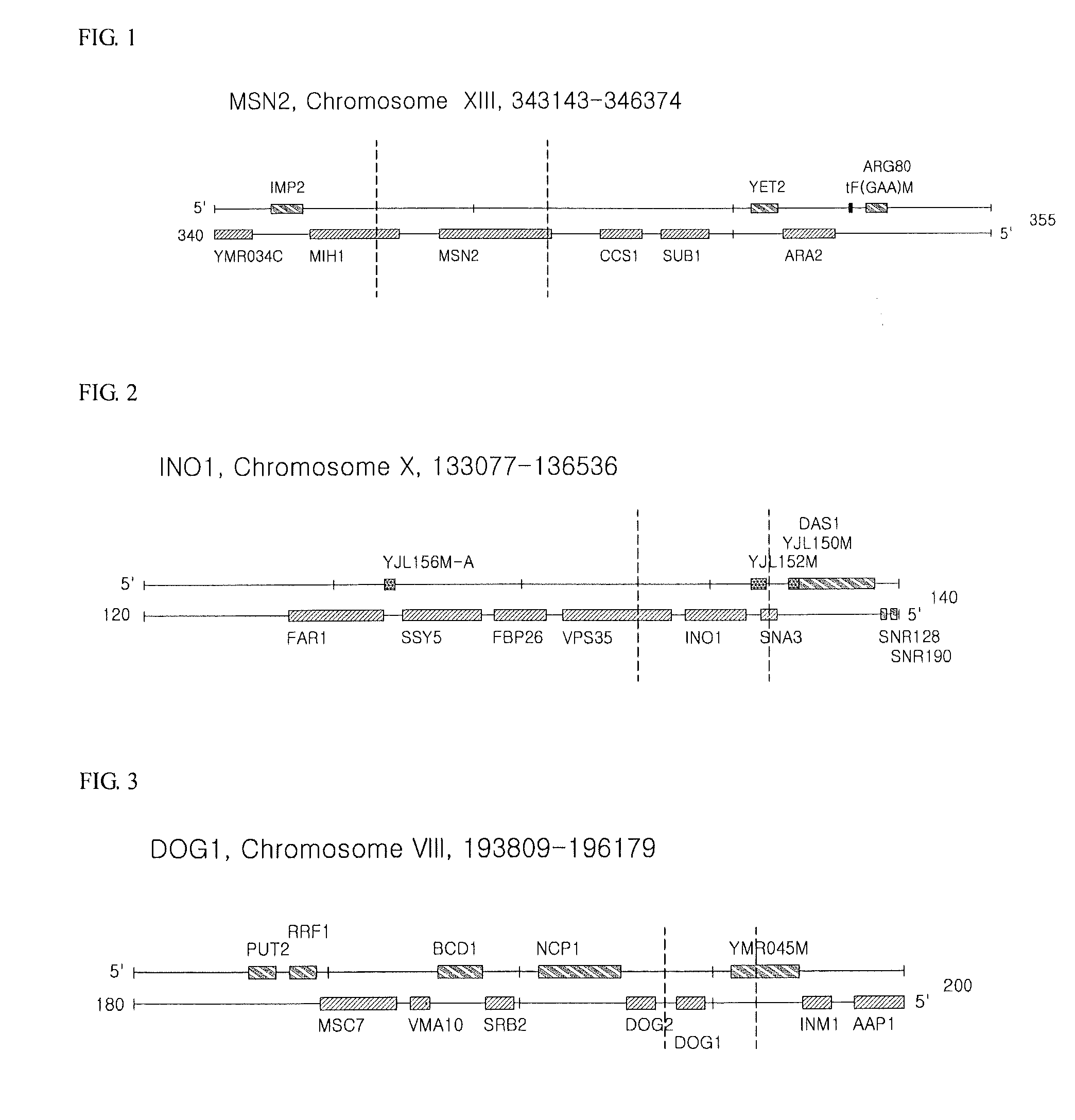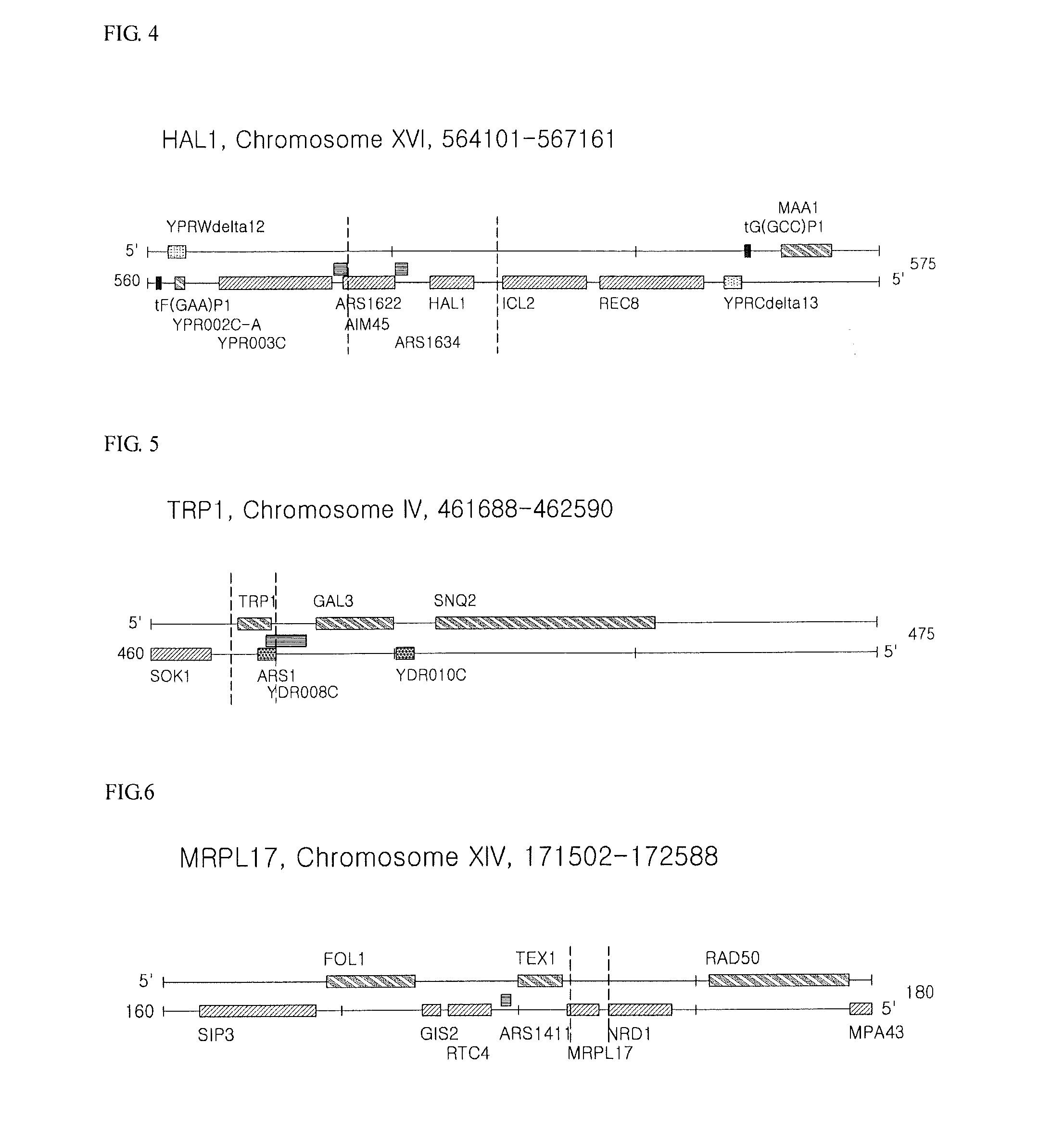Isolated polynucleotide for increasing alcohol tolerance of host cell, vector and host cell containing the same, and method of producing alcohol using the same
a technology of host cells and isolated polynucleotides, which is applied in the direction of peptides, organic chemistry, microorganisms, etc., can solve the problems of alcohol damage to microorganisms, and achieve the effects of increasing the alcohol tolerance of microorganisms, high volumetric productivity, and high viability and homeostasis
- Summary
- Abstract
- Description
- Claims
- Application Information
AI Technical Summary
Benefits of technology
Problems solved by technology
Method used
Image
Examples
example 1
Construction Example 1
1-1. Construction of Genomic Library
[0250]To construct the genomic library of strain CEN.PK2-1D of S. cerevisiae (MATalpha; ura3-52; trp1-289; leu2-3—112; his3 D1; MAL2-8C; SUC2), genomic S. cerevisiae DNA was first fragmented by sonication. Then, genomic fragments having sizes of 2 to 4 kilobases (kb) were selected on an agarose gel.
[0251]Subsequently, the multi-copy plasmid (pRS424) was digested with the restriction enzyme BamHI, and followed by a fill-in reaction to create blunt ends.
[0252]The selected genomic fragment was inserted into the blunt-ended pRS424 by ligation using the enzyme T4 DNA ligase. The plasmid containing the genomic fragment (e.g. isolated polynucleotide), constructed as described above, was transformed into E. coli and then amplified to construct the genomic DNA library.
1-2. Construction of Transformed Yeast Library
[0253]S. cerevisiae strain CEN.PK2-1D was incubated in yeast / peptone / dextrose (“YPD”) liquid media (containing 10 g of Yeas...
examples 1-8
[0258]Eight strains were selected by the selection according to Construction Example 1, and 8 plasmids were successfully isolated from each strain. The genomic sequence of the isolated polynucleotide contained in each plasmid was confirmed. To confirm the effects of overexpression for each of these sequences, the isolated plasmids were re-introduced into the S. cerevisiae CEN.PK2-1D parent strain using an EZ-Yeast Transformation Kit (MP Biomedicals), resulting in the host cells of Examples 1 to 8. The SEQ ID NOs and the names of the isolated polynucleotides included in the respective plasmids introduced into the host cells of Examples 1 to 8 are shown in Table 4.
TABLE 4ExampleSEQ ID NO:Name1261-1st polynucleotide2272-1st polynucleotide3283-1st polynucleotide4294-1st polynucleotide5305-1st polynucleotide6316-1st polynucleotide777th polynucleotide888th polynucleotide
experimental example 1
Cell Growth Rate in 5% (w / v) Ethanol Liquid Medium
[0259]Five % (w / v) ethanol-containing minimal medium was inoculated with strains of Examples 1 to 8 for stationary culture at 30° C. C. For the stationary culture, a 15 ml falcon tube and a minimal medium (SC medium) were used. Initial inoculation was carried out using an overnight culture at a low cell density (OD600: about 0.05) in the total volume of about 5 ml.
[0260]Every 12 hours, samples were taken from each culture, and cells were isolated and washed for measurement of optical density to analyze cell growth rate. The optical density (OD) was measured using a UV spectrophotometer (A600 nm).
[0261]The results are shown in FIG. 9. It can be seen from FIG. 9 that all host cells of Examples 1 to 8 show higher cell growth rates than the control group, wild-type S. cerevisiae yeast.
PUM
| Property | Measurement | Unit |
|---|---|---|
| temperature | aaaaa | aaaaa |
| temperature | aaaaa | aaaaa |
| temperature | aaaaa | aaaaa |
Abstract
Description
Claims
Application Information
 Login to View More
Login to View More - R&D
- Intellectual Property
- Life Sciences
- Materials
- Tech Scout
- Unparalleled Data Quality
- Higher Quality Content
- 60% Fewer Hallucinations
Browse by: Latest US Patents, China's latest patents, Technical Efficacy Thesaurus, Application Domain, Technology Topic, Popular Technical Reports.
© 2025 PatSnap. All rights reserved.Legal|Privacy policy|Modern Slavery Act Transparency Statement|Sitemap|About US| Contact US: help@patsnap.com



